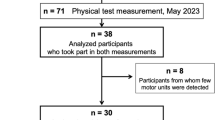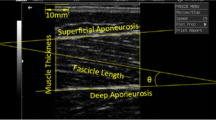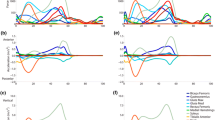Abstract
Redundancy in the human muscular system makes it challenging to assess age-related changes in muscle mechanical properties in vivo, as ethical considerations prohibit direct muscle force measurement. We overcame this by using a hybrid approach that combined magnetic resonance and ultrasound imaging, dynamometer measurements, muscle modeling, and numerical optimization to obtain subject-specific estimates of the mechanical properties of tibialis anterior, gastrocnemius, and soleus muscles from young and older adults. We hypothesized that older subjects would have lower maximal isometric forces, slower contractile and stiffer elastic characteristics, and that subject-specific muscle properties would give more accurate joint torque predictions compared to generic properties. Unknown muscle model parameters were obtained by minimizing the difference between simulated and actual subject torque-time histories under both isometric and isovelocity conditions. The resulting subject-specific models showed age- and gender-related differences, with older adults displaying reduced maximal isometric forces, slower force–velocity and altered force–length properties and stiffer elasticity. Tibialis anterior was least affected by aging. Subject-specific models gave good predictions of experimental concentric torque-time histories (10–14% error), but were less accurate for eccentric conditions. With generic muscle properties prediction errors were about twice as large. For maximum predictive power, musculoskeletal models should be tailored to individual subjects.





Similar content being viewed by others
References
Agur, A. M., V. Ng Thow Hing, K. A. Ball, E. Fiume, and N. H. McKee. Documentation and three dimensional modelling of human soleus muscle architecture. Clin. Anat. 16:285–293, 2003.
Arnold, E. M., S. R. Ward, R. L. Lieber, and S. L. Delp. A model of the lower limb for analysis of human movement. Ann. Biomed. Eng. 38:269–279, 2010.
Bahler, A. S. Series elastic component of mammalian skeletal muscle. Am. J. Physiol. 213:1560–1564, 1967.
Bahler, A. S. Modeling of mammalian skeletal muscle. IEEE Trans. Biomed. Eng. 15:249–257, 1968.
Baumgartner, R. N., D. L. Waters, D. Gallagher, J. E. Morley, and P. J. Garry. Predictors of skeletal muscle mass in elderly men and women. Mech. Ageing Dev. 107:123–136, 1999.
Blanpied, P., and G. L. Smidt. The difference in stiffness of the active plantarflexors between young and elderly human females. J. Gerontol. 48:M58–M63, 1993.
Bobbert, M. F., and G. J. van Ingen Schenau. Isokinetic plantar flexion: experimental results and model calculations. J. Biomech. 23:105–119, 1990.
Bojsen-Moller, J., P. Hansen, P. Aagaard, U. Svantesson, M. Kjaer, and S. P. Magnusson. Differential displacement of the human soleus and medial gastrocnemius aponeuroses during isometric plantar flexor contractions in vivo. J. Appl. Physiol. 97:1908–1914, 2004.
Brand, R. A., D. R. Pedersen, and J. A. Friederich. The sensitivity of muscle force predictions to changes in physiologic cross-sectional area. J. Biomech. 19:589–596, 1986.
Buchanan, T. S., D. G. Lloyd, K. Manal, and T. F. Besier. Estimation of muscle forces and joint moments using a forward-inverse dynamics model. Med. Sci. Sports Exerc. 37:1911–1916, 2005.
Caldwell, G. E., and A. E. Chapman. The general distribution problem: a physiological solution which includes antagonism. Hum. Mov. Sci. 10:355–392, 1991.
Chino, K., T. Oda, T. Kurihara, T. Nagayoshi, K. Yoshikawa, H. Kanehisa, T. Fukunaga, S. Fukashiro, and Y. Kawakami. In vivo fascicle behavior of synergistic muscles in concentric and eccentric plantar flexions in humans. J. Electromyogr. Kinesiol. 18:79–88, 2008.
Close, R. Dynamic properties of fast and slow skeletal muscles of the rat after nerve cross-union. J. Physiol. 204:331–346, 1969.
Close, R. I. Dynamic properties of mammalian skeletal muscles. Physiol. Rev. 52:129–197, 1972.
Cook, C., and M. McDonagh. Force responses to controlled stretches of electrically stimulated human muscle–tendon complex. Exp. Physiol. 80:477–490, 1995.
Delp, S. L., J. P. Loan, M. G. Hoy, F. E. Zajac, E. L. Topp, and J. M. Rosen. An interactive graphics-based model of the lower extremity to study orthopaedic surgical procedures. IEEE Trans. Biomed. Eng. 37:757–767, 1990.
Diffee, G. M., V. J. Caiozzo, R. E. Herrick, and K. M. Baldwin. Contractile and biochemical properties of rat soleus and plantaris after hindlimb suspension. Am. J. Physiol. Cell Physiol. 260:C528–C534, 1991.
Edman, K. A., C. Caputo, and F. Lou. Depression of tetanic force induced by loaded shortening of frog muscle fibres. J. Physiol. 466:535–552, 1993.
Edman, K. A., G. Elzinga, and M. I. Noble. Enhancement of mechanical performance by stretch during tetanic contractions of vertebrate skeletal muscle fibres. J. Physiol. 281:139–155, 1978.
Enoka, R. M. Eccentric contractions require unique activation strategies by the nervous system. J. Appl. Physiol. 81:2339–2346, 1996.
Epstein, M., and W. Herzog. Theoretical Models of Skeletal Muscle. New York: Wiley, 1998.
FitzHugh, R. A model of optimal voluntary muscular control. J. Math. Biol. 4:203–236, 1977.
Frontera, W. R., D. Suh, L. S. Krivickas, V. A. Hughes, R. Goldstein, and R. Roubenoff. Skeletal muscle fiber quality in older men and women. Am. J. Physiol. Cell Physiol. 279:C611–C618, 2000.
Fukashiro, S., M. Rob, Y. Ichinose, Y. Kawakami, and T. Fukunaga. Ultrasonography gives directly but noninvasively elastic characteristic of human tendon in vivo. Eur. J. Appl. Physiol. Occup. Physiol. 71:555–557, 1995.
Fukunaga, T., K. Kubo, Y. Kawakami, S. Fukashiro, H. Kanehisa, and C. N. Maganaris. In vivo behaviour of human muscle tendon during walking. Proc. R. Soc. B 268:229, 2001.
Garner, B. A., and M. G. Pandy. Estimation of musculotendon properties in the human upper limb. Ann. Biomed. Eng. 31:207–220, 2003.
Gordon, A. M., A. F. Huxley, and F. J. Julian. The variation in isometric tension with sarcomere length in vertebrate muscle fibres. J. Physiol. 184:170–192, 1966.
Harman, S. M., E. J. Metter, J. D. Tobin, J. Pearson, and M. R. Blackman. Longitudinal effects of aging on serum total and free testosterone levels in healthy men. J. Clin. Endocrinol. Metab. 86:724–731, 2001.
Hasson, C. J., J. A. Kent-Braun, and G. E. Caldwell. Contractile and non-contractile tissue volume and distribution in ankle muscles of young and older adults. J. Biomech. 44:2299–2306, 2011.
Hasson, C. J., R. H. Miller, and G. E. Caldwell. Contractile and elastic ankle joint muscular properties in young and older adults. PLoS One 6:e15953, 2011.
Henriksson-Larsén, K. B., J. Lexell, and M. Sjöström. Distribution of different fibre types in human skeletal muscles. I. Method for the preparation and analysis of cross-sections of whole tibialis anterior. Histochem. J. 15:167–178, 1983.
Hill, A. V. The heat of shortening and the dynamic constants of muscle. Proc. R. Soc. B 126B:136–195, 1938.
Hill, A. V. First and Last Experiments in Muscle Mechanics. London: Cambridge Press, 1970.
Hof, A. L. Muscle mechanics and neuromuscular control. J. Biomech. 36:1031–1038, 2003.
Hoy, M. G., F. E. Zajac, and M. E. Gordon. A musculoskeletal model of the human lower extremity: the effect of muscle, tendon, and moment arm on the moment–angle relationship of musculotendon actuators at the hip, knee, and ankle. J. Biomech. 23:157–169, 1990.
Huijing, P. A. Important experimental factors for skeletal muscle modelling: non-linear changes of muscle length force characteristics as a function of degree of activity. Eur. J. Morphol. 34:47–54, 1996.
Jakobsson, F., K. Borg, L. Edström, and L. Grimby. Use of motor units in relation to muscle fiber type and size in man. Muscle Nerve 11:1211–1218, 1988.
Johnson, M. A., J. Polgar, D. Weightman, and D. Appleton. Data on the distribution of fibre types in thirty-six human muscles: an autopsy study. J. Neurol. Sci. 18:111–129, 1973.
Kannus, P., M. Paavola, and L. Józsa. Aging and degeneration of tendons. In: Tendon Injuries: Basic Science and Clinical Medicine, edited by N. Maffulli, P. Renström, and W. B. Leadbetter. London: Springer, 2005, pp. 25–31.
Kent-Braun, J. A., and A. V. Ng. Specific strength and voluntary muscle activation in young and elderly women and men. J. Appl. Physiol. 87:22–29, 1999.
Klass, M., S. Baudry, and J. Duchateau. Aging does not affect voluntary activation of the ankle dorsiflexors during isometric, concentric, and eccentric contractions. J. Appl. Physiol. 99:31–38, 2005.
Lanza, I. R., T. F. Towse, G. E. Caldwell, D. M. Wigmore, and J. A. Kent-Braun. Effects of age on human muscle torque, velocity, and power in two muscle groups. J. Appl. Physiol. 95:2361–2369, 2003.
Larsson, L., X. Li, and W. R. Frontera. Effects of aging on shortening velocity and myosin isoform composition in single human skeletal muscle cells. Am. J. Physiol. 272:C638–C649, 1997.
Loram, I. D., C. N. Maganaris, and M. Lakie. Paradoxical muscle movement in human standing. J. Physiol. 556:683–689, 2004.
Lundberg, A., O. Svensson, G. Nemeth, and G. Selvik. The axis of rotation of the ankle joint. J. Bone Joint Surg. Br. 71:94–99, 1989.
Maganaris, C. N., V. Baltzopoulos, and A. J. Sargeant. In vivo measurements of the triceps surae complex architecture in man: implications for muscle function. J. Physiol. 512(Pt 2):603–614, 1998.
Maganaris, C. N., V. Baltzopoulos, and A. J. Sargeant. Changes in the tibialis anterior tendon moment arm from rest to maximum isometric dorsiflexion: in vivo observations in man. Clin. Biomech. 14:661–666, 1999.
Morgan, D. New insights into the behavior of muscle during active lengthening. Biophys. J. 57:209–221, 1990.
Narici, M. V., C. N. Maganaris, N. D. Reeves, and P. Capodaglio. Effect of aging on human muscle architecture. J. Appl. Physiol. 95:2229–2234, 2003.
Ochala, J., W. R. Frontera, D. J. Dorer, J. Van Hoecke, and L. S. Krivickas. Single skeletal muscle fiber elastic and contractile characteristics in young and older men. J. Gerontol. A Biol. Sci. Med. Sci. 62:375–381, 2007.
Ochala, J., D. Lambertz, M. Pousson, F. Goubel, and J. V. Hoecke. Changes in mechanical properties of human plantar flexor muscles in ageing. Exp. Gerontol. 39:349–358, 2004.
Out, L., T. G. Vrijkotte, A. J. van Soest, and M. F. Bobbert. Influence of the parameters of a human triceps surae muscle model on the isometric torque–angle relationship. J. Biomech. Eng. 118:17–25, 1996.
Rugg, S. G., R. J. Gregor, B. R. Mandelbaum, and L. Chiu. In vivo moment arm calculations at the ankle using magnetic resonance imaging (MRI). J. Biomech. 23:495–501, 1990.
Scovil, C. Y., and J. L. Ronsky. Sensitivity of a Hill-based muscle model to perturbations in model parameters. J. Biomech. 39:2055–2063, 2006.
Shao, Q., D. N. Bassett, K. Manal, and T. S. Buchanan. An EMG-driven model to estimate muscle forces and joint moments in stroke patients. Comput. Biol. Med. 39:1083–1088, 2009.
Simoneau, E., A. Martin, and J. Van Hoecke. Effects of joint angle and age on ankle dorsi- and plantar-flexor strength. J. Electromyogr. Kinesiol. 17:307–316, 2007.
Spoor, C. W., J. L. van Leeuwen, W. J. van der Meulen, and A. Huson. Active force–length relationship of human lower-leg muscles estimated from morphological data: a comparison of geometric muscle models. Eur. J. Morphol. 29:137–160, 1991.
Storn, R., and K. Price. Differential evolution—a simple and efficient adaptive scheme for global optimization over continuous spaces. Technical Report TR-95-012, International Computer Science Institute, 1995.
Thelen, D. G. Adjustment of muscle mechanics model parameters to simulate dynamic contractions in older adults. J. Biomech. Eng. 125:70–77, 2003.
Toursel, T., L. Stevens, and Y. Mounier. Evolution of contractile and elastic properties of rat soleus muscle fibres under unloading conditions. Exp. Physiol. 84:93–107, 1999.
Wickiewicz, T. L., R. R. Roy, P. L. Powell, and V. R. Edgerton. Muscle architecture of the human lower limb. Clin. Orthop. Relat. Res. 179:275–283, 1983.
Wilkie, D. R. The relation between force and velocity in human muscle. J. Physiol. 110:249–280, 1950.
Winters, J. M. Hill-based muscle models: a systems engineering perspective. In: Multiple Muscle Systems: Biomechanics and Movement Organization, edited by J. M. Winters, and S. L.-Y. Woo. New York: Springer, 1990, pp. 69–93.
Woittiez, R. D., P. A. Huijing, and R. H. Rozendal. Influence of muscle architecture on the length-force diagram. A model and its verification. Pflugers Arch. 397:73–74, 1983.
Zajac, F. E. Muscle and tendon: properties, models, scaling, and application to biomechanics and motor control. Crit. Rev. Biomed. Eng. 17:359–411, 1989.
Acknowledgments
This research was supported by NIH grant R03AG026281. We would like to thank Jeff Gagnon for assistance with muscle modeling.
Author information
Authors and Affiliations
Corresponding author
Additional information
Associate Editor Thurmon E. Lockhart oversaw the review of this article.
Appendix
Appendix
Each muscle–tendon unit was represented by a two-component Hill-type32 model. This phenomenological lumped-parameter model incorporated a contractile element (CE) in series with an elastic element (SEE). The behavior of the CE was defined by excitation–activation, force–length, and force–velocity relations. The behavior of the SEE was defined by a force–extension relation. Both force–length and force–velocity relations were linearly scaled with activation.
Excitation–Activation Relationship
An exponential characterized the relationship between the excitation input to the muscle model and the activation of the CE.7 Upon receiving an excitatory input μ, the time-course for rising CE activation λ was
where i denotes the sample number, Δt is the time-step, and τ is a time constant specifying the rate of activation.
Force–Length Relationship
The isometric force producing potential of the CE (FP) depended on the maximal isometric force capability of the CE (P 0), the activation (λ), and normalized CE length (L CE/L 0). The latter specifies the position on the force length relation, which is defined as an inverted parabola with width coefficient W, such that
Force–Velocity Relationship
The force–velocity relation was defined by a rectangular hyperbola based on Hill,33 which has been shown in many experimental preparations.4,13,14 The shape of this relation is determined by the constants a and b, which can be expressed as normalized values a/P 0 and b/L 0.33 If the instantaneous force generated by the CE (P) is less than FP the CE must be shortening, such that
where v CE is the CE velocity. If P is greater than FP, the CE must be lengthening. Therefore, based on FitzHugh22
where ε is the saturation force for an eccentric contraction (eccentric plateau).
Force–Extension Relationship
The amount of SEE extension for a given force relative to the SEE slack length L S, i.e., the stiffness, was defined by a second-order polynomial. The length of the SEE (L SEE) was given by
where α and β are coefficients defining the shape of the polynomial.
Muscle Model Force Change
The rate of change of muscle force with respect to time is given by
where v SEE is the velocity of the SEE, given by
where v MT is the velocity of the musculotendon complex. During model simulation, this force change was integrated to give the muscle force at the next time step.
Rights and permissions
About this article
Cite this article
Hasson, C.J., Caldwell, G.E. Effects of Age on Mechanical Properties of Dorsiflexor and Plantarflexor Muscles. Ann Biomed Eng 40, 1088–1101 (2012). https://doi.org/10.1007/s10439-011-0481-4
Received:
Accepted:
Published:
Issue Date:
DOI: https://doi.org/10.1007/s10439-011-0481-4




